Start, Stop, Continue Retrospective helps teams reflect on their performance, identify areas for improvement, and celebrate their successes. In this comprehensive guide, we will explore the fundamentals of the Start, Stop, Continue Retrospective technique, its applicability for different audiences, the best times to use it, and the availability of free templates, including those offered by Boardmix, to facilitate this valuable exercise.
What is the Start, Stop Continue Retrospective Technique?
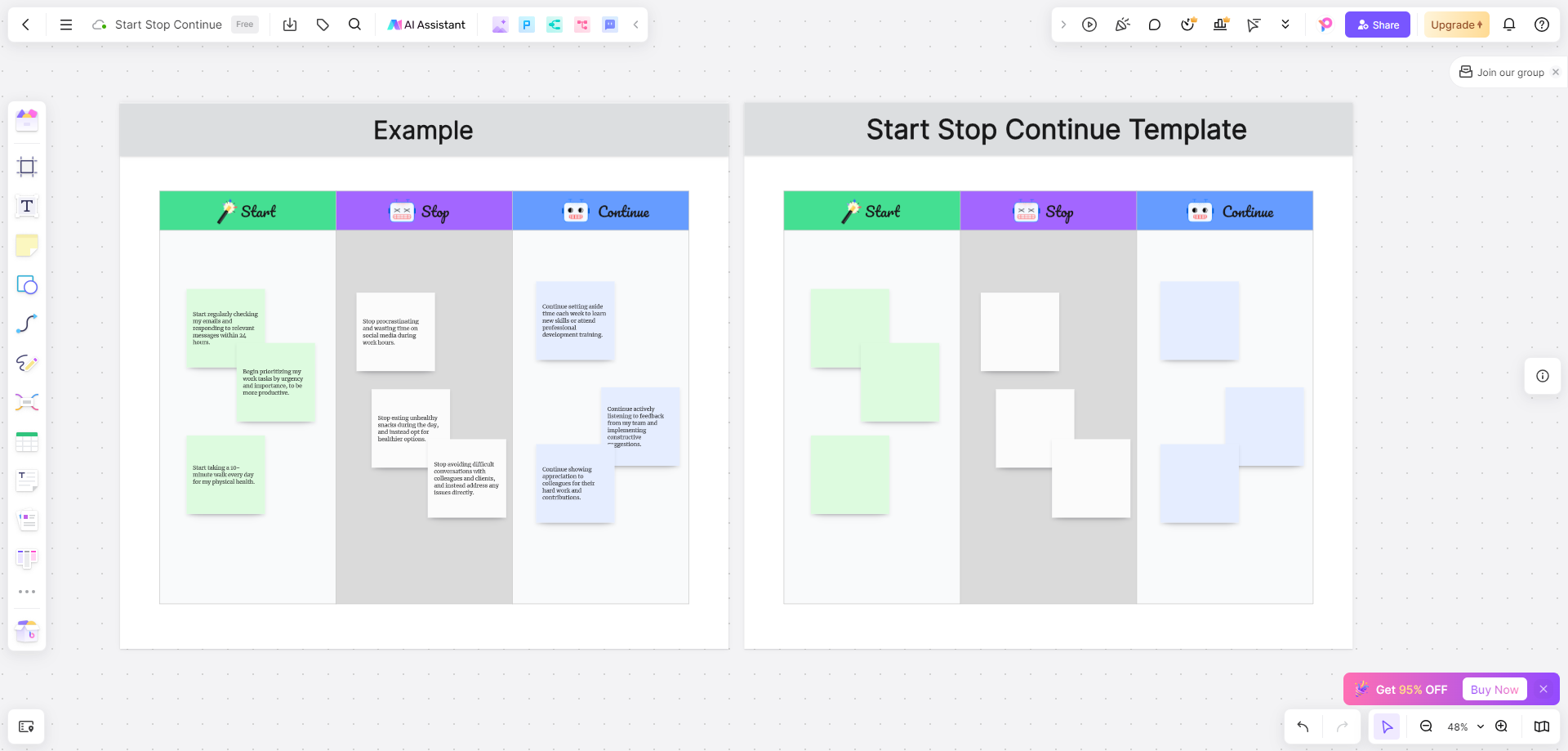
The Start, Stop, Continue Retrospective is a straightforward and versatile feedback mechanism used by teams to reflect on their processes and practices. The technique is divided into three sections:
Start: Identifying new actions or practices the team should begin implementing to improve performance.
Stop: Recognizing existing behaviors or processes that are hindering progress and should be discontinued.
Continue: Highlighting current practices that are working well and should be maintained.
This structured approach allows teams to have focused discussions, making it easier to pinpoint specific actions for improvement and build on existing strengths.
Who is Start, Stop Continue Technique for?
The Start, Stop, Continue Retrospective technique is versatile and can be applied to various groups, including:
1. Project Teams
Project teams can use this technique at the end of each sprint or project phase to assess their performance and identify actionable steps for improvement. Boardmix offers templates tailored for project teams, providing a digital platform where team members can collaborate in real time, regardless of their location. These templates help streamline the feedback process, ensuring that all voices are heard.
2. Educational Settings
Teachers and students can use this technique to evaluate classroom activities, teaching methods, and learning experiences. It promotes a culture of continuous learning and improvement. Boardmix provides educational templates, which can be customized to suit various educational needs, making them a valuable tool for fostering a growth mindset.
3. Corporate Teams
Corporate teams can benefit from this technique during performance reviews, team meetings, or strategic planning sessions. It helps in aligning team efforts with organizational goals. Boardmix's corporate templates are designed to facilitate structured feedback sessions, enabling teams to efficiently capture and analyze feedback. This leads to more effective decision-making and strategic planning.
4. Personal Development
Individuals can use the Start, Stop, Continue technique for personal growth and self-improvement. It helps in setting personal goals and tracking progress. Boardmix offers personal development templates that help individuals organize their thoughts and reflect on their personal and professional journeys. These templates provide a structured approach to self-assessment and goal setting.
5. Community Groups
Community groups and non-profit organizations can use this technique to evaluate their programs and initiatives. It fosters community engagement and continuous improvement. Boardmix's community templates are designed to facilitate collaborative discussions, making it easier for community members to share their feedback and ideas. This promotes a sense of ownership and collective responsibility.
When and Why You Should Use Start, Stop Continue?
The main goal of the Start, Stop, Continue retrospective is to make your next project or initiative run more smoothly. Studies have shown that formalized feedback and goal-setting practices increase worker productivity and performance, and Start, Stop, Continue is an effective ways to accomplish that.
When to Use Start, Stop, Continue?
Like most feedback models, it’s best to apply this method right after you complete a project or reach a milestone. Setting a meeting date sooner rather than later ensures the triumphs and struggles of the process are fresh on your team’s minds. Once you discuss those important points, you can implement changes faster.
- After You Deliver a Project
- When an Initiative Fails or Succeeds
- At the End of the Year (Calendar or Fiscal)
- When You Feel Stagnant
- After a Sprint in an Agile Workflow
- During Performance Reviews
Why You Should Use Start, Stop, Continue?
After completing a challenging project, you might be tempted to move on and forget the stress, especially if it didn’t go well. Although you should take time to pat yourself on the back—rewarding yourself is crucial—skipping a rigorous review robs you and your team of the chance to learn and grow. Here’s why you should use the Start, Stop, Continue technique:
1. Promotes Continuous Improvement
The technique encourages a mindset of ongoing improvement by regularly evaluating what to start, stop, and continue. This leads to incremental progress and sustained growth.
2. Encourages Constructive Feedback
The Start, Stop, and Continue method promotes constructive and actionable feedback by focusing on specific actions and behaviors. This helps in addressing issues without causing conflict and supports positive change.
3. Align actions with Goals
Regularly using this technique ensures that the team’s actions are aligned with organizational or personal goals. This alignment enhances efficiency and effectiveness in achieving desired outcomes.
4. Supports Reflective Practices
Whether in educational settings, corporate environments, or personal development, the Start, Stop, Continue technique promotes reflective practices. This reflection helps individuals and teams to learn from their experiences and apply these lessons to future activities.
5. Facilitates Strategic Planning
By incorporating this technique into strategic planning sessions, teams can ensure that their strategies are continuously refined and adapted to meet changing circumstances and goals. This dynamic approach enhances strategic agility and competitiveness.
6. Improves Decision-Making
The structured approach of the Start, Stop, Continue method provides clear insights into what works and what doesn’t. This clarity enhances decision-making processes and leads to more informed and effective choices.
Free Start, Stop Continue Retrospective Templates
Using templates can simplify the Start, Stop, Continue retrospective process by providing structured formats that guide discussions and ensure all important points are covered. Here are some examples of free templates, each tailored for specific contexts and needs:
1. Project Management Template
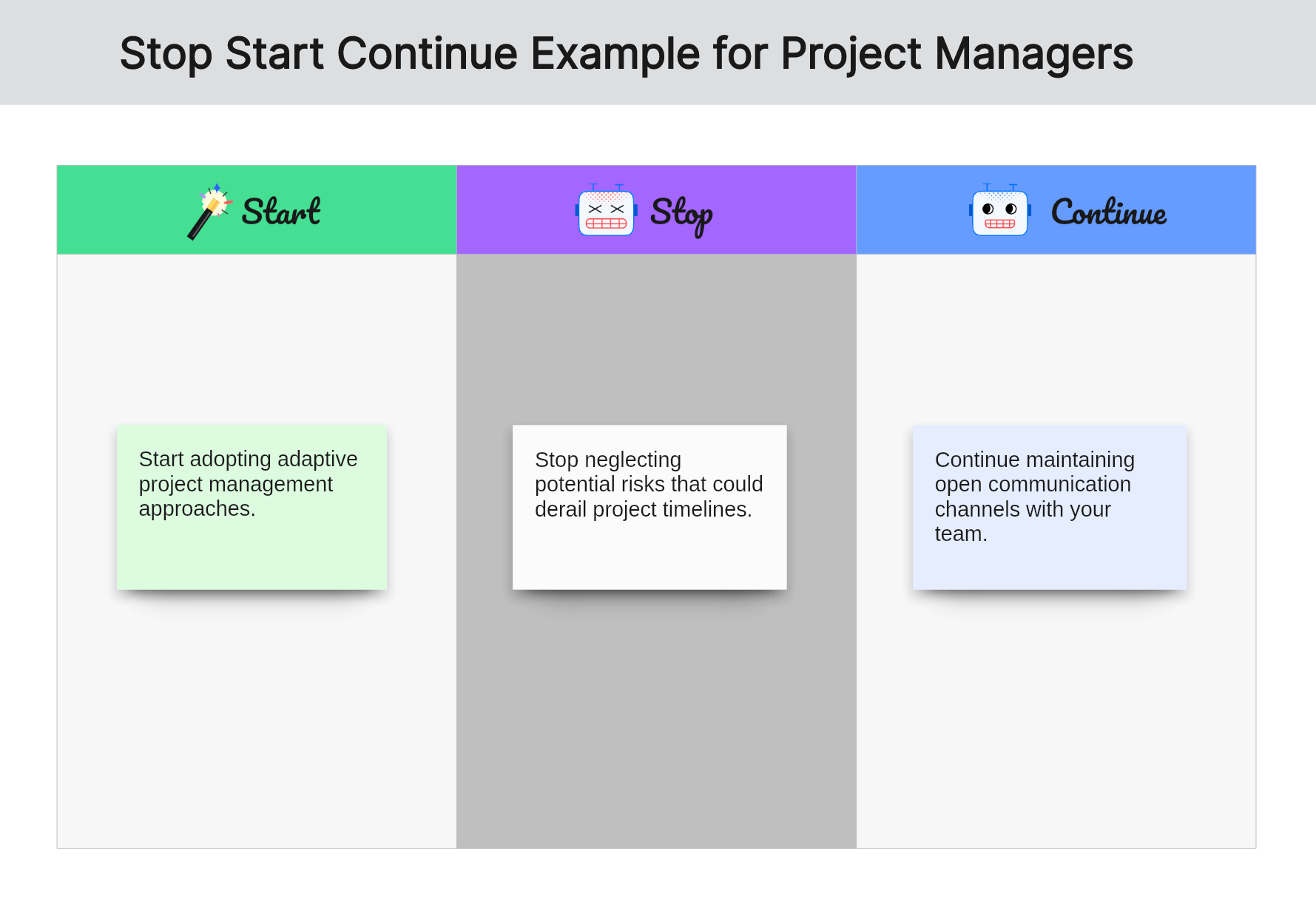
Designed specifically for project management, this template includes additional fields to capture detailed project insights and action items.
Content:
Start: New project strategies, resources needed, and innovative tools.
Stop: Inefficient workflows, outdated tools, and redundant processes.
Continue: Effective communication methods, successful project phases, and best practices.
Applicability:
Ideal For: Project managers and teams at a project's or major milestone's end.
Uses: Post-project reviews, milestone assessments, and strategic planning sessions.
2. Agile Sprint Retrospective Template
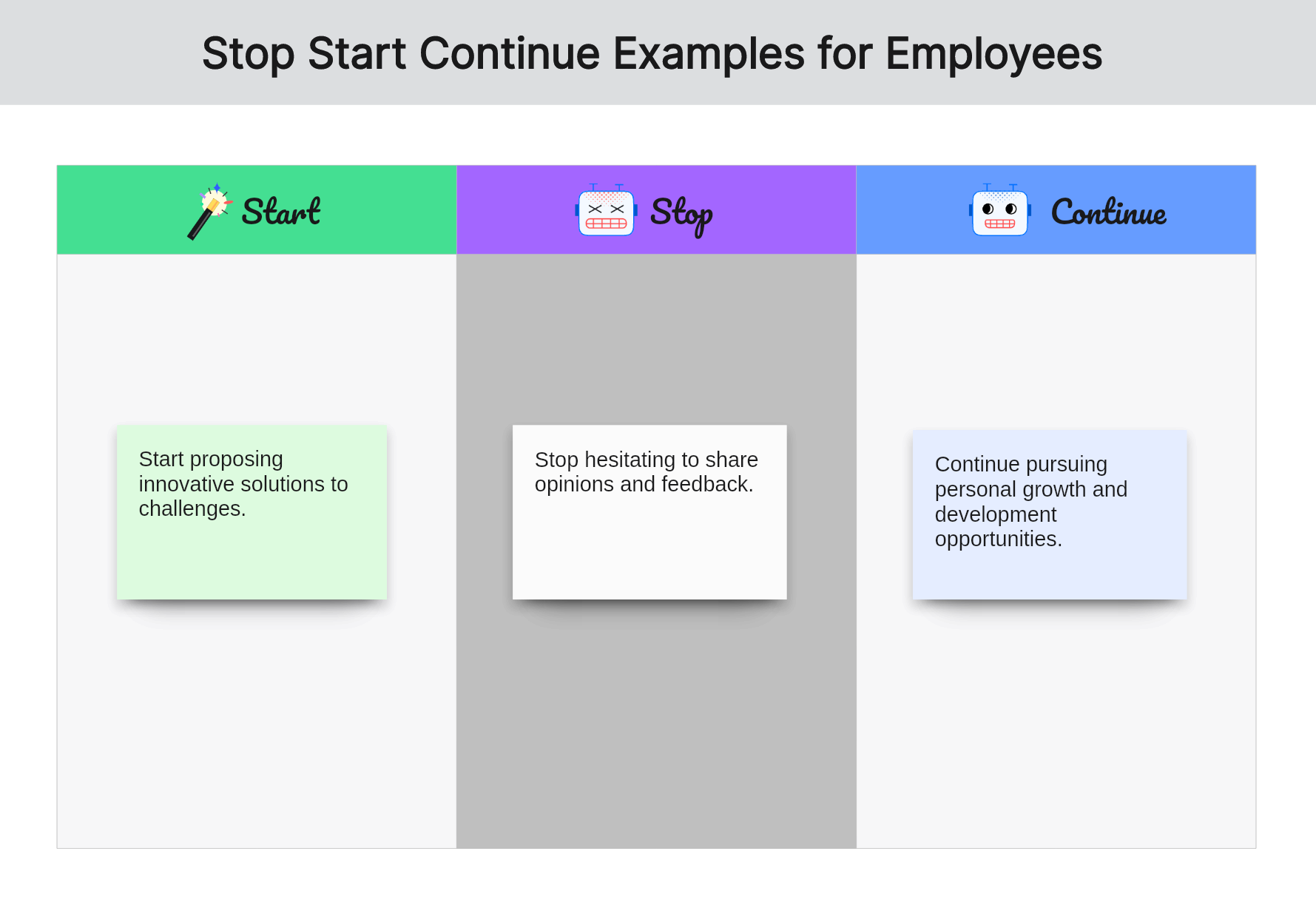
Tailored for Agile teams, this template aligns with the sprint cycle and focuses on iterative improvement.
Content:
Start: New practices to try in the next sprint, stakeholder feedback, and additional resources.
Stop: Bottlenecks identified in the sprint, recurring issues, and unnecessary meetings.
Continue: Sprint practices that enhance productivity, effective teamwork, and successful deliveries.
Applicability:
Ideal For: Agile teams conducting sprint retrospectives.
Uses: End-of-sprint reviews, Agile workflow improvements, and continuous development processes.
3. Educational Template
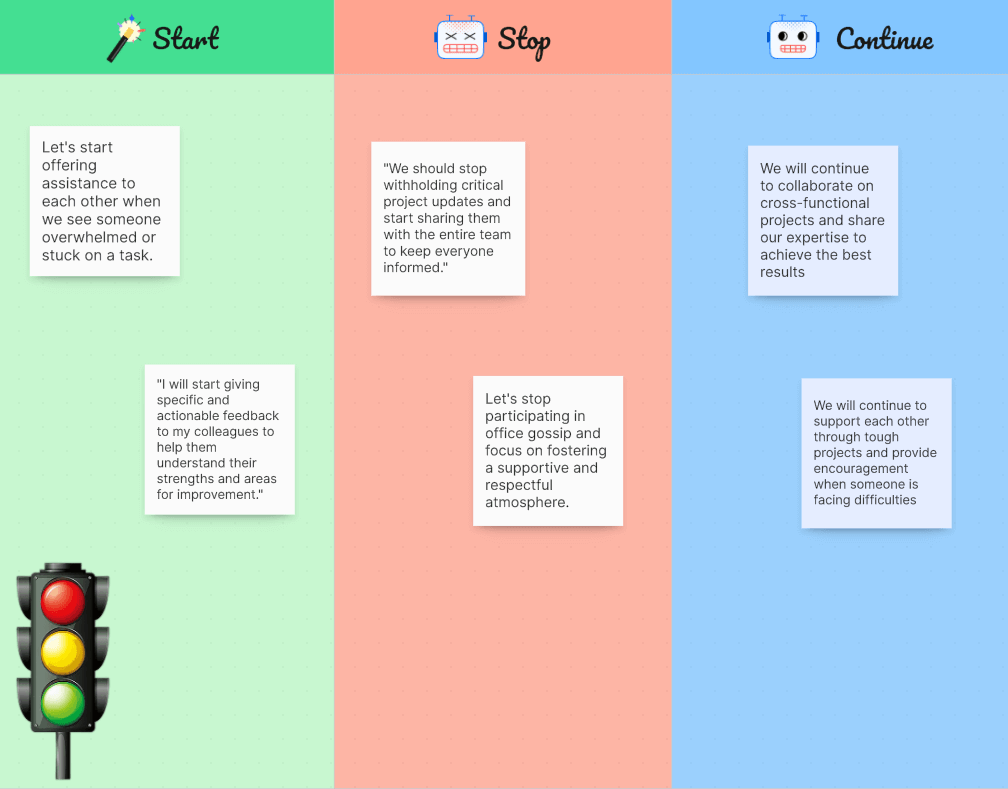
The educational start, stop and continue template is designed for educational settings, helping teachers and students reflect on teaching methods, classroom activities, and learning outcomes.
Content:
Start: New teaching strategies, interactive activities, and technology tools.
Stop: Ineffective teaching methods, unengaging activities, and outdated materials.
Continue: Successful lesson plans, engaging activities, and effective assessments.
Applicability:
Ideal For: Teachers, students, and educational administrators.
Uses: End-of-term evaluations, classroom activity reviews, and professional development sessions.
4. Personal Development Template
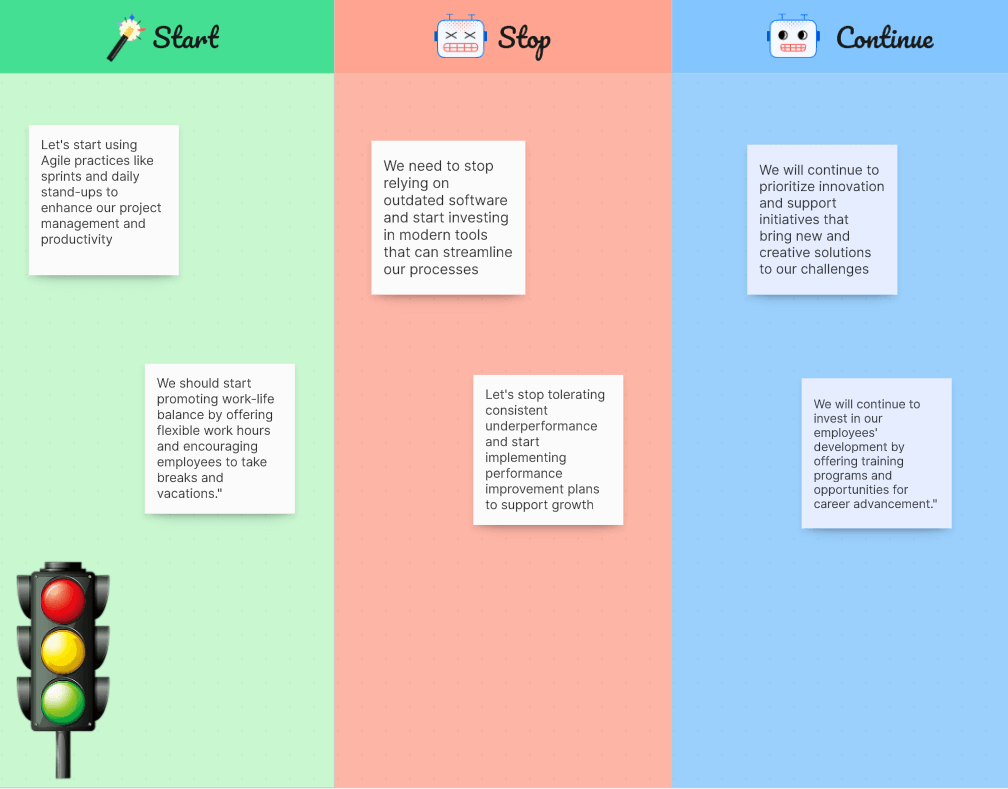
Focusing on individual growth, this template helps people reflect on their personal and professional progress, set new goals, and plan for improvement.
Content:
Start: New habits, skills to learn, and personal goals.
Stop: Unproductive behaviors, time-wasting activities, and bad habits.
Continue: Successful habits, progress skills, and achieve goals.
Applicability:
Ideal For: Individuals seeking personal growth and self-improvement.
Uses: Monthly reflections, career planning, and personal goal setting.
The Start, Stop, Continue Retrospective technique is a versatile and powerful tool for fostering continuous improvement across various settings. Whether used by project teams, educators, corporate groups, or individuals, it provides a structured approach to reflecting on past performance and identifying actionable steps for the future. With the availability of free templates, including those offered by Boardmix, implementing this technique has never been easier. By incorporating Start, Stop, Continue into your regular practices, you can enhance performance, boost morale, and achieve greater success in your personal and professional endeavors. Start your journey of continuous improvement today!








